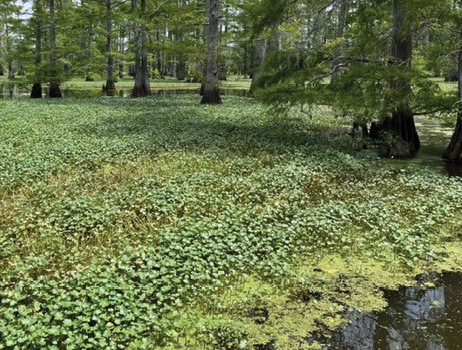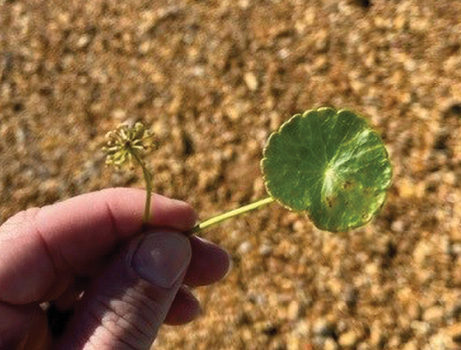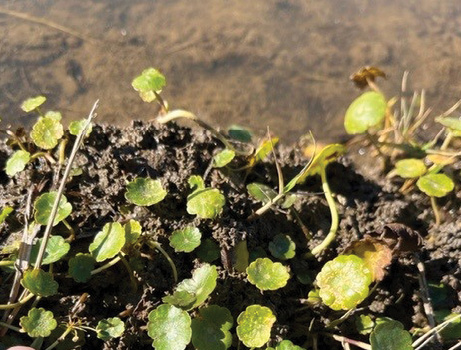Water Pennywort | Hydrocotye spp.
Emergent | Native



from shallow margins.
Water pennywort is a member of the carrot family (Apiaceae) and is commonly found growing adjacent to or floating as a mat on the surface of slow-moving and calm waters. It is typically less than a foot tall.
The circular, slightly lobed leaves are deep green, shiny, and leathery. There is a pale dot in the middle where the stem attaches on the leaf underside. Faint veins radiate out from the center like spokes of a wheel. Leaves can be up to 3 inches in diameter but are usually about the size of a silver dollar coin.
Stems are pale green to brownish white. These round stems are thick and spongy, allowing them to float on the water’s surface. Short flower stalks can form on the horizontal stems, giving rise to a small cluster of pale flowers.
Management Value
Water pennywort seeds are occasionally eaten by ducks, and leaves and stems are eaten by some insects. However, it can form dense stands that interfere with recreational use, so it is not recommended for pond management.
Recommended Controls
Option 1: 2,4-D (3.8-pound formulation). For each gallon of water, mix 1.25 ounces 2,4-D and 1.3 ounces non-ionic surfactant. Spray to wet all plants. Do not exceed annual herbicide rate limits as stated on the product label.
Option 2: Glyphosate (5.4-pound formulation). For each gallon of water, mix 0.5 ounce glyphosate and 1.3 ounces non-ionic surfactant. Spray to wet all plants. Do not exceed annual herbicide rate limits as stated on the product label.
The best approach is to treat ponds with herbicide when the water temperature is at least 60˚F and the plants are actively growing. Multiple applications may be necessary to achieve eradication.
Read and follow all chemical label instructions, especially the section on the use of personal protection equipment.

The information given here is for educational purposes only. References to commercial products, trade names, or suppliers are made with the understanding that no endorsement is implied and that no discrimination against other products or suppliers is intended.
Publication 3735-36 (POD-11-23)
By Wes Neal, PhD, Extension/Research Professor, Wildlife, Fisheries, and Aquaculture; Dennis Riecke, Fisheries Coordinator, Mississippi Department of Wildlife, Fisheries, and Parks; and Gray Turnage, PhD, Assistant Research/Extension Professor, GeoSystems Research Institute.
The Mississippi State University Extension Service is working to ensure all web content is accessible to all users. If you need assistance accessing any of our content, please email the webteam or call 662-325-2262.



